欧盟食品中重金属限量标准(中文)
- 格式:docx
- 大小:32.01 KB
- 文档页数:5
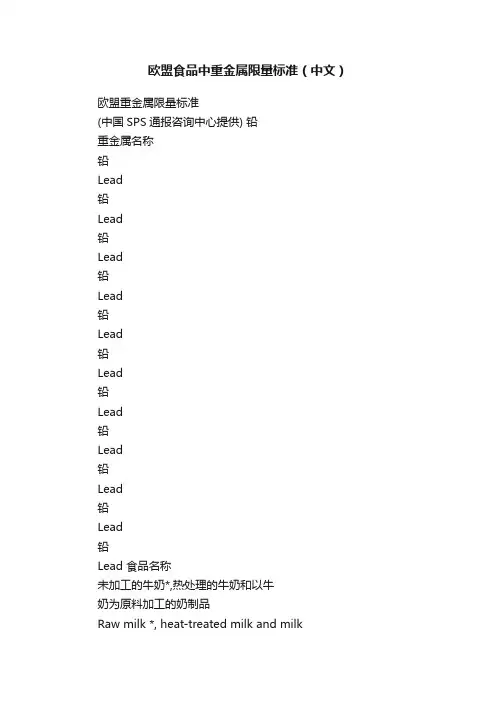
欧盟食品中重金属限量标准(中文)欧盟重金属限量标准(中国SPS通报咨询中心提供) 铅重金属名称铅Lead铅Lead铅Lead铅Lead铅Lead铅Lead铅Lead铅Lead铅Lead铅Lead铅Lead 食品名称未加工的牛奶*,热处理的牛奶和以牛奶为原料加工的奶制品Raw milk *, heat-treated milk and milkfor the man婴儿食品和后续食品Infant formulae and follow-o nformulae限量国家备注欧盟*Foodstuffs listed inthis category as defined inThe maximum level0.020 欧盟 refers to the productsready to牛、羊、猪和家禽肉,不包括下Meat (excludi ng offal) of bovi ne 0.10ani mals, sheep, p牛、羊、猪和家禽的下水Offal of bovine animals, sheep, pig and 0.50 poultry鱼的肌肉0.30Muscle meat of fish甲壳类,不包括螃蟹的褐色肉、龙虾和大小相当的甲壳类(Nephropidae andPali nur 0.50Crustacea ns, excludi ng brow n meat of crab and excl双壳类动物1.5Bivalve molluscs头足类动物1.0Cephalopods (without viscera)谷类、豆荚和豆科植物0.20Cereals, legumes and pulses蔬菜,不包括芸苔蔬菜、叶类蔬菜、新鲜草药和菌类,土豆的最大限量适用于去皮土豆0.10Vegetables, excludi ng brassica vegetables, leaf ve芸苔蔬菜、叶类蔬菜和食用菌Brassica vegetables, leaf vegetables and 0.30cultivate, Foodstuffs listed in this 欧盟category as defi ned in R, Foodstuffs listed in this 欧盟category as defi ned in RFish listed in this 欧盟category as defined in categor欧盟Foodstuffs falli ng within category ? and (f) ofthFoodstuffs falli ng within 欧盟category ? and (f) of thFoodstuffs falli ng within 欧盟category ? and (f) of th欧盟The maximum level 欧盟applies after washing ofthe fruThe maximum level 欧盟applies after washing of thefru序号1 2 3 4 5 6 7 8 91011铅 12 Lead铅 13Lead 铅 14Lead铅 15Lead果汁,作为重新制造的浓缩果汁和果蜜」 Foodstuffs listed in thisFruit juices, concentrated fruit juices as 0.050 欧盟 category as defi ned in C reconst限量国家备注镉 1Cadmium 镉 2Cadmium 镉 3Cadmium镉 4Cadmium镉 5Cadmium镉 6Cadmium果实,不包括浆果和小果实Fruit, excluding berries and small fruit浆果和小果Berries and small fruit 脂肪和油,包括奶油Fats and oils, in cludi ng milk fatThe maximum level0.10 欧盟 applies after washing ofthe fruThe maximum level0.20 欧盟 applies after washing ofthe fru0.10欧盟香酒、加酒芬香的饮料和加酒芬香的鸡铅尾酒*, *Foodstuffs listed in this 70.20# 欧盟LeadAromatized wine, aromatized category as defi ned inwin e-based drinks and、镉序号重金属名称食品名称牛、羊、猪和家禽肉,不包括下水Meat (excludi ng offal) of bovi neani mals, sheep, p 马肉,不包括下水Horsemeat, exclud ing offal (6) 牛、羊、猪、家禽、马肝脏Liver of bovine animals, sheep, pig,poultry and h牛、羊、猪、家禽、马肾脏Kidney of bovine animals, sheep, pig, poultry and鱼肉,不包括 3.2.6和3.2.7中列出的那些鱼肉Muscle meat offish , exclud ing species listed in3.2.6下列鱼的肉:凤尾鱼 (Engraulis种)、鰹(Sarda sarda)常见的—Foodstuffs listed in this0.050欧盟category as defi ned in R , Foodstuffs listed in this0.20欧盟category as defi ned in R , Foodstuffs listed in this 0.50欧盟+category as defi ned in RFoodstuffs listed in this酒(包括汽酒,不包括利口酒),苹果酒,梨酒和果酒*16 Lead0.20#Wine(in cludi ng sparkli ng wine,excludi ng liqueur欧盟 *Foodstuffs listed inthis category as defi nedin1.0 欧盟category as defi ned in RFish listed in this 0.050 欧盟 category as defined in categor Fish listed in this0.10欧盟category as defined inCadmium镉 CadmiumMuscle meat of the follow ing fish :an chovy (En grau 3.2.7 旗鱼的肉(Xiphias gladius)3.2.7 Muscle meat of swordfish (Xiphias 0.30 gladius) 甲壳类,不包括螃蟹的褐色肉、龙虾和大小相当的甲壳类 (Nephropidae andPali nur欧盟 0.50 欧盟categorFish listed in thiscategory as defined in categorCrustacea ns, excludi ng brow n meat crab and excl of Foodstuffs falli ng with in category ? and (f) of th 9 Cadmium 镉Bivalve molluscs头足类软体动物(没有内脏) 1.0 欧盟101.0 欧盟Cadmium Cephalopods (without viscera)镉谷物不包括麸、酵母、小麦和大米11 Cereals excluding bran, germ, wheat and 0.10 欧盟Cadmiumrice镉麸、酵母、小麦和大米120.20 欧盟Cadmium Bran, germ, wheat and rice镉大豆130.20 欧盟CadmiumSoybeans蔬菜和水果,叶类蔬菜除外,茎类蔬镉菜,松子,根类蔬菜和马铃薯140.050欧盟 CadmiumVegetables and fruit, excluding leafvegetables, f叶类蔬菜,新鲜中草药,食用菌和块镉根芹150.20 欧盟 CadmiumLeaf vegetables, fresh herbs, cultivatedfungi and茎类蔬菜,根类蔬菜和番茄,块根芹。
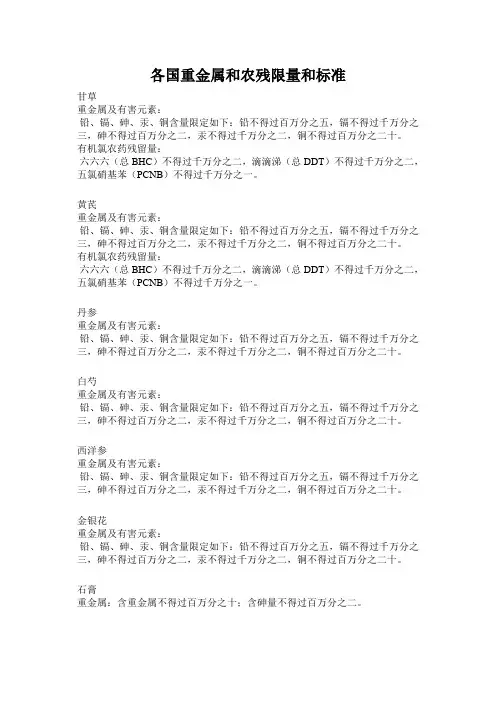
各国重金属和农残限量和标准甘草重金属及有害元素:铅、镉、砷、汞、铜含量限定如下:铅不得过百万分之五,镉不得过千万分之三,砷不得过百万分之二,汞不得过千万分之二,铜不得过百万分之二十。
有机氯农药残留量:六六六(总BHC)不得过千万分之二,滴滴涕(总DDT)不得过千万分之二,五氯硝基苯(PCNB)不得过千万分之一。
黄芪重金属及有害元素:铅、镉、砷、汞、铜含量限定如下:铅不得过百万分之五,镉不得过千万分之三,砷不得过百万分之二,汞不得过千万分之二,铜不得过百万分之二十。
有机氯农药残留量:六六六(总BHC)不得过千万分之二,滴滴涕(总DDT)不得过千万分之二,五氯硝基苯(PCNB)不得过千万分之一。
丹参重金属及有害元素:铅、镉、砷、汞、铜含量限定如下:铅不得过百万分之五,镉不得过千万分之三,砷不得过百万分之二,汞不得过千万分之二,铜不得过百万分之二十。
白芍重金属及有害元素:铅、镉、砷、汞、铜含量限定如下:铅不得过百万分之五,镉不得过千万分之三,砷不得过百万分之二,汞不得过千万分之二,铜不得过百万分之二十。
西洋参重金属及有害元素:铅、镉、砷、汞、铜含量限定如下:铅不得过百万分之五,镉不得过千万分之三,砷不得过百万分之二,汞不得过千万分之二,铜不得过百万分之二十。
金银花重金属及有害元素:铅、镉、砷、汞、铜含量限定如下:铅不得过百万分之五,镉不得过千万分之三,砷不得过百万分之二,汞不得过千万分之二,铜不得过百万分之二十。
石膏重金属:含重金属不得过百万分之十;含砷量不得过百万分之二。
煅石膏重金属:含重金属不得过百万分之十。
白矾重金属:含重金属不得过百万分之二十。
玄明粉重金属:含重金属不得过百万分之二十。
含砷量不得过百万分之二十。
地龙重金属:含重金属不得过百万分之三十。
芒硝重金属:含重金属不得过百万分之十。
含砷量不得过百万分之十。
西瓜霜重金属:含重金属不得过百万分之十。
含砷量不得过百万分之十。
冰片(合成龙脑)重金属:含重金属不得过百万分之五。
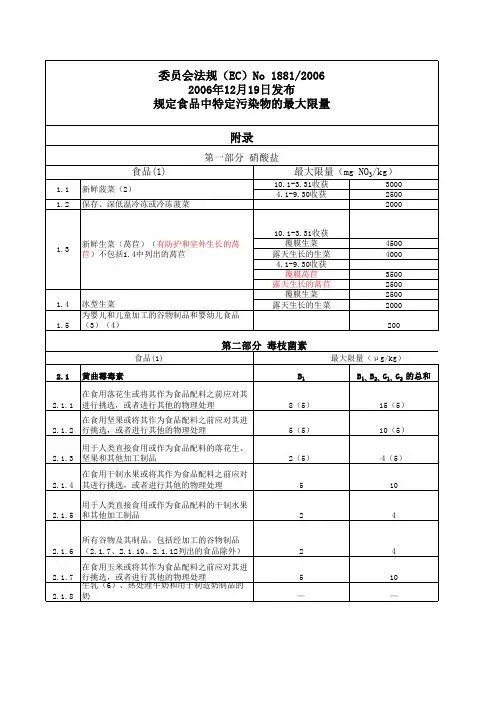
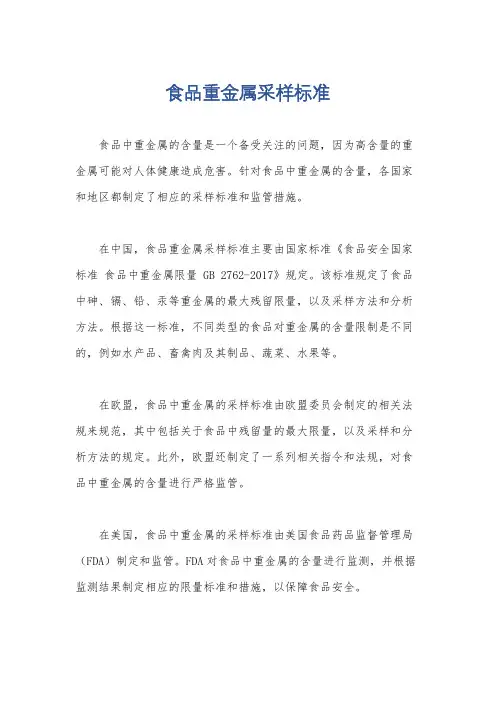
食品重金属采样标准
食品中重金属的含量是一个备受关注的问题,因为高含量的重金属可能对人体健康造成危害。
针对食品中重金属的含量,各国家和地区都制定了相应的采样标准和监管措施。
在中国,食品重金属采样标准主要由国家标准《食品安全国家标准食品中重金属限量 GB 2762-2017》规定。
该标准规定了食品中砷、镉、铅、汞等重金属的最大残留限量,以及采样方法和分析方法。
根据这一标准,不同类型的食品对重金属的含量限制是不同的,例如水产品、畜禽肉及其制品、蔬菜、水果等。
在欧盟,食品中重金属的采样标准由欧盟委员会制定的相关法规来规范,其中包括关于食品中残留量的最大限量,以及采样和分析方法的规定。
此外,欧盟还制定了一系列相关指令和法规,对食品中重金属的含量进行严格监管。
在美国,食品中重金属的采样标准由美国食品药品监督管理局(FDA)制定和监管。
FDA对食品中重金属的含量进行监测,并根据监测结果制定相应的限量标准和措施,以保障食品安全。
总的来说,不同国家和地区针对食品中重金属的采样标准可能会有所不同,但都致力于保障食品安全,降低食品中重金属对人体健康的潜在危害。
这些采样标准的制定和执行,有助于监管食品生产过程中的重金属污染,保护消费者的健康。
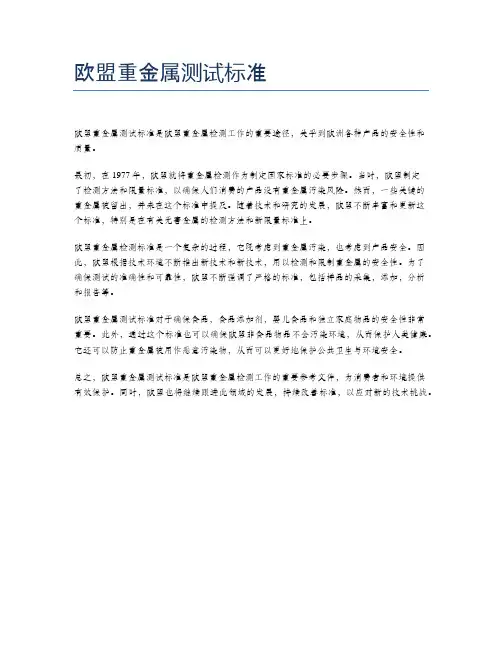
欧盟重金属测试标准
欧盟重金属测试标准是欧盟重金属检测工作的重要途径,关乎到欧洲各种产品的安全性和质量。
最初,在1977年,欧盟就将重金属检测作为制定国家标准的必要步骤。
当时,欧盟制定
了检测方法和限量标准,以确保人们消费的产品没有重金属污染风险。
然而,一些关键的重金属被留出,并未在这个标准中提及。
随着技术和研究的发展,欧盟不断丰富和更新这个标准,特别是在有关无害金属的检测方法和新限量标准上。
欧盟重金属检测标准是一个复杂的过程,它既考虑到重金属污染,也考虑到产品安全。
因此,欧盟根据技术环境不断推出新技术和新技术,用以检测和限制重金属的安全性。
为了确保测试的准确性和可靠性,欧盟不断强调了严格的标准,包括样品的采集,添加,分析和报告等。
欧盟重金属测试标准对于确保食品,食品添加剂,婴儿食品和独立家庭物品的安全性非常重要。
此外,通过这个标准也可以确保欧盟非食品物品不会污染环境,从而保护人类健康。
它还可以防止重金属被用作恶意污染物,从而可以更好地保护公共卫生与环境安全。
总之,欧盟重金属测试标准是欧盟重金属检测工作的重要参考文件,为消费者和环境提供有效保护。
同时,欧盟也将继续跟进此领域的发展,持续改善标准,以应对新的技术挑战。
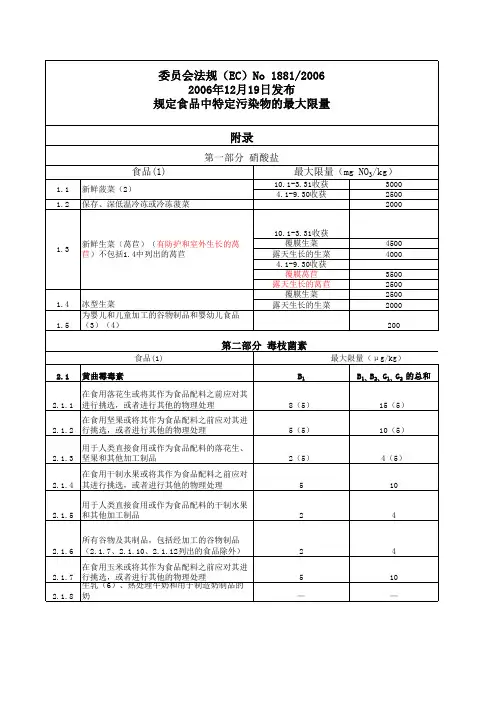
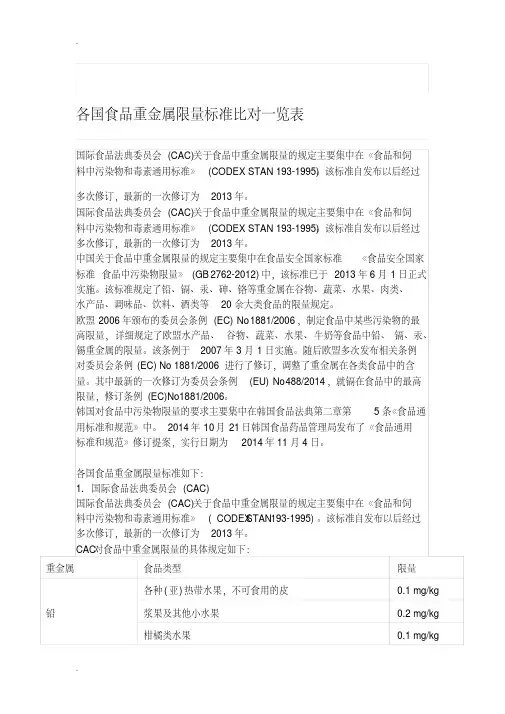
各国食品重金属限量标准比对一览表国际食品法典委员会(CAC)关于食品中重金属限量的规定主要集中在《食品和饲料中污染物和毒素通用标准》(CODEX STAN 193-1995)。
该标准自发布以后经过多次修订,最新的一次修订为2013年。
国际食品法典委员会(CAC)关于食品中重金属限量的规定主要集中在《食品和饲料中污染物和毒素通用标准》(CODEX STAN 193-1995)。
该标准自发布以后经过多次修订,最新的一次修订为2013年。
中国关于食品中重金属限量的规定主要集中在食品安全国家标准《食品安全国家标准食品中污染物限量》(GB 2762-2012)中,该标准已于2013年6月1日正式实施。
该标准规定了铅、镉、汞、砷、铬等重金属在谷物、蔬菜、水果、肉类、水产品、调味品、饮料、酒类等20余大类食品的限量规定。
欧盟2006年颁布的委员会条例(EC) No 1881/2006,制定食品中某些污染物的最高限量,详细规定了欧盟水产品、谷物、蔬菜、水果、牛奶等食品中铅、镉、汞、锡重金属的限量。
该条例于2007年3月1日实施。
随后欧盟多次发布相关条例对委员会条例(EC) No 1881/2006进行了修订,调整了重金属在各类食品中的含量。
其中最新的一次修订为委员会条例(EU) No 488/2014,就镉在食品中的最高限量,修订条例(EC)No1881/2006。
韩国对食品中污染物限量的要求主要集中在韩国食品法典第二章第5条《食品通用标准和规范》中。
2014年10月21日韩国食品药品管理局发布了《食品通用标准和规范》修订提案,实行日期为2014年11月4日。
各国食品重金属限量标准如下:1. 国际食品法典委员会(CAC)国际食品法典委员会(CAC)关于食品中重金属限量的规定主要集中在《食品和饲料中污染物和毒素通用标准》( CODEX STAN 193-1995)。
该标准自发布以后经过多次修订,最新的一次修订为2013年。
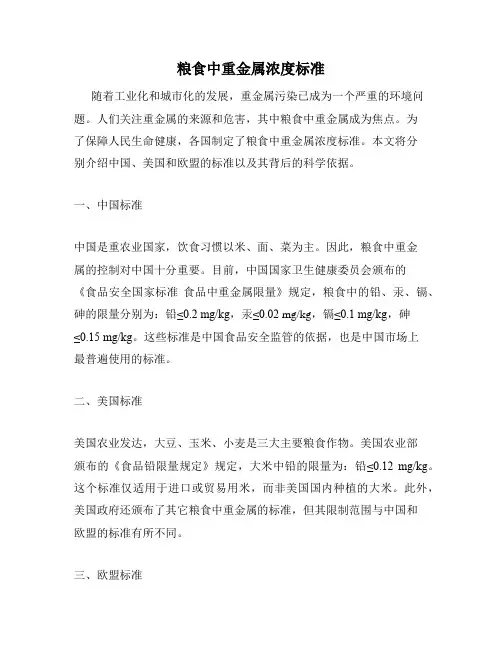
粮食中重金属浓度标准随着工业化和城市化的发展,重金属污染已成为一个严重的环境问题。
人们关注重金属的来源和危害,其中粮食中重金属成为焦点。
为了保障人民生命健康,各国制定了粮食中重金属浓度标准。
本文将分别介绍中国、美国和欧盟的标准以及其背后的科学依据。
一、中国标准中国是重农业国家,饮食习惯以米、面、菜为主。
因此,粮食中重金属的控制对中国十分重要。
目前,中国国家卫生健康委员会颁布的《食品安全国家标准食品中重金属限量》规定,粮食中的铅、汞、镉、砷的限量分别为:铅≤0.2 mg/kg,汞≤0.02 mg/kg,镉≤0.1 mg/kg,砷≤0.15 mg/kg。
这些标准是中国食品安全监管的依据,也是中国市场上最普遍使用的标准。
二、美国标准美国农业发达,大豆、玉米、小麦是三大主要粮食作物。
美国农业部颁布的《食品铅限量规定》规定,大米中铅的限量为:铅≤0.12 mg/kg。
这个标准仅适用于进口或贸易用米,而非美国国内种植的大米。
此外,美国政府还颁布了其它粮食中重金属的标准,但其限制范围与中国和欧盟的标准有所不同。
三、欧盟标准欧盟是世界上最大的农业进口国之一。
为了保障食品安全,欧盟制定了一系列食品中重金属限量标准。
其中,欧盟食品安全局(EFSA)规定了农产品中的镉限量为:镉≤0.05 mg/kg。
同时,欧盟还颁布了其他重金属的限制,并指出了这些限制的科学依据。
四、科学依据粮食中重金属的标准是经过科学评估和风险分析的。
重金属对人体的危害包括:神经、肝、肾、免疫、生殖、血液等多种器官和系统的损害。
这些重金属会积聚在人体内部,长期摄入可能导致慢性中毒。
因此,各国制定的粮食中重金属限制标准都是根据科学研究评估的结果,并考虑到人体的健康风险。
总之,随着全球化和国际贸易的发展,粮食中重金属的污染问题愈发重要。
了解各个国家的粮食中重金属限制标准的差异和科学依据有助于更好地掌握粮食安全局势,并且有利于消费者做出更有利于自己身体健康的食品选择。
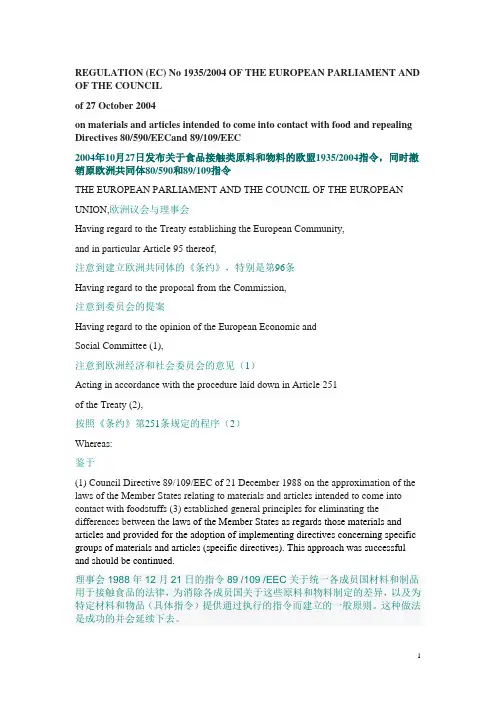
REGULATION (EC) No 1935/2004 OF THE EUROPEAN PARLIAMENT AND OF THE COUNCILof 27 October 2004on materials and articles intended to come into contact with food and repealing Directives 80/590/EECand 89/109/EEC2004年10月27日发布关于食品接触类原料和物料的欧盟1935/2004指令,同时撤销原欧洲共同体80/590和89/109指令THE EUROPEAN PARLIAMENT AND THE COUNCIL OF THE EUROPEAN UNION,欧洲议会与理事会Having regard to the Treaty establishing the European Community,and in particular Article 95 thereof,注意到建立欧洲共同体的《条约》,特别是第96条Having regard to the proposal from the Commission,注意到委员会的提案Having regard to the opinion of the European Economic andSocial Committee (1),注意到欧洲经济和社会委员会的意见(1)Acting in accordance with the procedure laid down in Article 251of the Treaty (2),按照《条约》第251条规定的程序(2)Whereas:鉴于(1) Council Directive 89/109/EEC of 21 December 1988 on the approximation of the laws of the Member States relating to materials and articles intended to come into contact with foodstuffs (3) established general principles for eliminating the differences between the laws of the Member States as regards those materials and articles and provided for the adoption of implementing directives concerning specific groups of materials and articles (specific directives). This approach was successful and should be continued.理事会1988年12月21日的指令89 /109 /EEC关于统一各成员国材料和制品用于接触食品的法律,为消除各成员国关于这些原料和物料制定的差异,以及为特定材料和物品(具体指令)提供通过执行的指令而建立的一般原则。
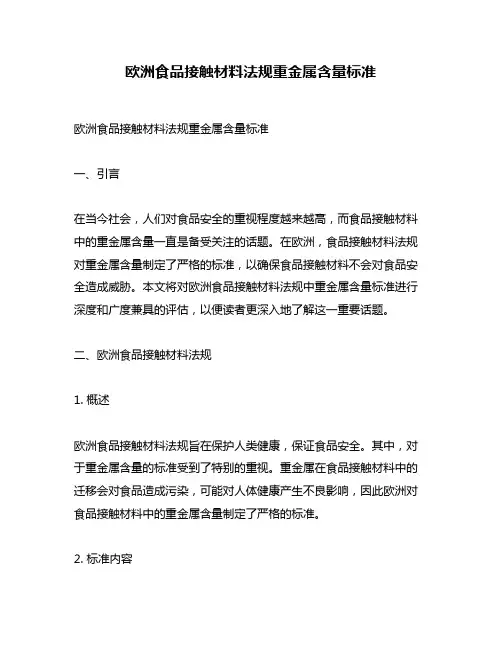
欧洲食品接触材料法规重金属含量标准欧洲食品接触材料法规重金属含量标准一、引言在当今社会,人们对食品安全的重视程度越来越高,而食品接触材料中的重金属含量一直是备受关注的话题。
在欧洲,食品接触材料法规对重金属含量制定了严格的标准,以确保食品接触材料不会对食品安全造成威胁。
本文将对欧洲食品接触材料法规中重金属含量标准进行深度和广度兼具的评估,以便读者更深入地了解这一重要话题。
二、欧洲食品接触材料法规1. 概述欧洲食品接触材料法规旨在保护人类健康,保证食品安全。
其中,对于重金属含量的标准受到了特别的重视。
重金属在食品接触材料中的迁移会对食品造成污染,可能对人体健康产生不良影响,因此欧洲对食品接触材料中的重金属含量制定了严格的标准。
2. 标准内容根据欧洲食品接触材料法规,包括铅、镉、汞和铬在内的重金属在食品接触材料中的迁移量都必须符合规定的标准。
具体来说,对于铅的限量为0.05毫克/升,对于镉的限量为0.01毫克/升,对于汞的限量为0.005毫克/升,对于铬的限量为0.1毫克/升。
3. 监管机构欧洲食品安全局(EFSA)是负责制定和监督食品接触材料法规的主要机构。
其严格的监管措施和标准化的测试方法保障了食品接触材料中重金属含量的监测和管理。
三、个人观点和理解在我看来,欧洲对食品接触材料中重金属含量的严格监管体现了其对食品安全的高度重视和保护消费者健康的决心。
这种监管体系的建立对于保障食品安全,提升消费者信心起到了积极的作用。
这也对食品接触材料行业提出了更高的要求,促使企业加强品质管理,提高产品质量。
四、总结与回顾通过本文的全面评估,我们对欧洲食品接触材料法规中的重金属含量标准有了更深入的了解。
这些标准的制定和监管体系的建立在保障食品安全、保护消费者健康方面发挥着重要作用。
我个人认为,相关企业应当加强对食品接触材料中重金属含量的监测和管理,以确保产品质量和消费者健康。
在本文中,我们系统地介绍了欧洲食品接触材料法规中的重金属含量标准,并对其进行了深度和广度兼具的评估。
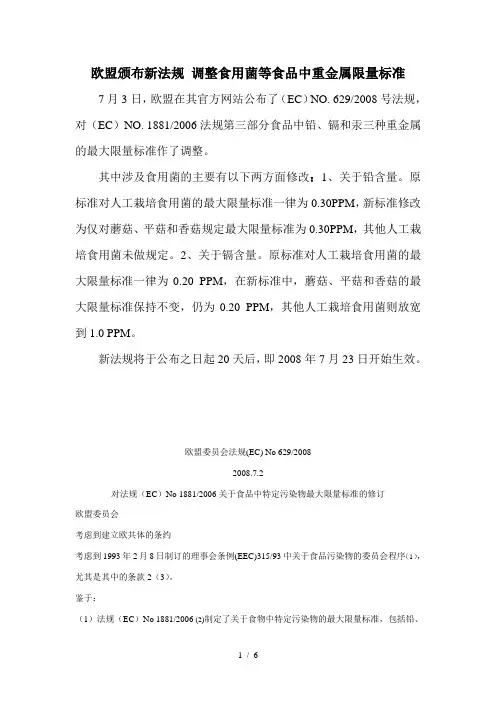
欧盟颁布新法规调整食用菌等食品中重金属限量标准7月3日,欧盟在其官方网站公布了(EC)NO. 629/2008号法规,对(EC)NO. 1881/2006法规第三部分食品中铅、镉和汞三种重金属的最大限量标准作了调整。
其中涉及食用菌的主要有以下两方面修改:1、关于铅含量。
原标准对人工栽培食用菌的最大限量标准一律为0.30PPM,新标准修改为仅对蘑菇、平菇和香菇规定最大限量标准为0.30PPM,其他人工栽培食用菌未做规定。
2、关于镉含量。
原标准对人工栽培食用菌的最大限量标准一律为0.20 PPM,在新标准中,蘑菇、平菇和香菇的最大限量标准保持不变,仍为0.20 PPM,其他人工栽培食用菌则放宽到1.0 PPM。
新法规将于公布之日起20天后,即2008年7月23日开始生效。
欧盟委员会法规(EC) No 629/20082008.7.2对法规(EC)No 1881/2006关于食品中特定污染物最大限量标准的修订欧盟委员会考虑到建立欧共体的条约考虑到1993年2月8日制订的理事会条例(EEC)315/93中关于食品污染物的委员会程序(1),尤其是其中的条款2(3)。
鉴于:(1)法规(EC)No 1881/2006 (2)制定了关于食物中特定污染物的最大限量标准,包括铅、镉和汞等重金属含量的限定。
(2)为保护公众健康,保证污染物的含量水平不会成为健康隐患成为当务之急。
铅、镉和汞的最大含量必须在安全水平,在良好生产和规范农业/ 渔业操作的基础上,尽可能保持低含量。
(3)根据新资讯,即使是良好农业和规范渔业操作也不能使某些水生物种和食用菌中铅、镉和汞的含量继续维持在法规(EC)No 1881/2006附件中所规定的水平。
因此需要修改那些污染物的最大限量标准,以此保证高水平的消费者健康保护。
(4)欧洲议会2002/46/EC号决定第2条款和2002年6月10日讨论各成员国关于食品添加剂类似法规的理事会会议(3)都定义了食品添加剂。
欧盟各国对六种有害物质限值(ROHS)一、镉的法规要求:⒈欧盟:ROHS,91/338/EEC,94/62/EC,76/769/EEC Limit=100ppm 瑞典:Limit=75ppm(mg/Kg)丹麦:Limit=75ppm(mg/Kg)瑞士:Limit=100ppm(mg/Kg)荷兰:Limit=100ppm(mg/Kg)⒉ROHS豁免项:除了91/338/EEC禁止使用的产品除外,生产设备、机器等产品的电镀镉可以豁免。
二.铅的法规要求:⒈欧盟:76/769/EEC,89/677/EEC:禁止使用94/62/EC:<100ppmROHS:<1000ppm⒉ROHS豁免项:玻璃:如荧光管etc.合金:钢合金中铅含量<0.35%(3500ppm);玻璃:如荧光管etc.合金:钢合金中铅含量<0.35%(3500ppm);铝中铅含量<0.4%(4000ppm);铜合金中铅含量<4%(40000ppm)焊锡:高温融化的焊料中的铅(即锡铅焊料合金中铅含量超过85%);用于服务器、存储器和存储系统的焊料中的铅(豁免准予至2010年);用于交换、信号和传输,以及电信网络管理的网络基础设施设备中焊料中的铅;电子陶瓷产品中的铅如压电陶瓷。
⒊ROHS豁免听证项:光学玻璃及护目镜可以使用铅及镉;两个以上焊接口之微处理器封装跟其针头,可使用铅占85%比重的锡铅焊料,唯其期限到2010年;溶解度较高的含铅焊料(如锡铅焊合金有85%的铅)及任何需要低温焊接以完成电力接驳的焊料。
三、汞的法规要求:⒈欧盟:76/769/EEC,89/677/EEC:禁止使用;94/62/EC:<100ppm;ROHS:<1000ppm。
⒉ROHS豁免项:荧光灯及灯具。
四、六价铬的法规要求:⒈欧盟:76/769/EEC:禁止使用;94/62/EC:<100ppm;ROHS:<1000ppm。
粮食中重金属浓度标准介绍重金属是指密度大于5克/立方厘米的金属元素,其中包括铅、汞、镉、铬等。
这些重金属在自然界中普遍存在,但由于人类活动的影响,造成了重金属在环境和食物中的积累。
人体长期摄入重金属超标食物会对健康产生不良影响,因此设定粮食中重金属浓度标准对于保护公众健康至关重要。
国际标准不同国家和地区对粮食中重金属浓度标准有不同的要求。
以下是一些国际标准的概述:1.美国标准:–铅:粮食中铅的最大容许浓度为2-10毫克/千克,具体取决于粮食类型。
–汞:粮食中汞的最大容许浓度为0.1毫克/千克。
–镉:粮食中镉的最大容许浓度为0.1毫克/千克。
2.欧盟标准:–铅:粮食中铅的最大容许浓度为0.1毫克/千克。
–汞:粮食中汞的最大容许浓度为0.02毫克/千克。
–镉:粮食中镉的最大容许浓度为0.02毫克/千克。
3.中国标准:–铅:粮食中铅的最大容许浓度为0.2毫克/千克。
–汞:粮食中汞的最大容许浓度为0.05毫克/千克。
–镉:粮食中镉的最大容许浓度为0.1毫克/千克。
重金属对健康的影响重金属的积累对人体健康有潜在风险,以下是一些常见重金属及其对健康的影响:1.铅:–铅中毒:长期摄入超过标准的铅会导致铅中毒,影响神经系统、代谢和免疫系统。
–儿童发育迟缓:儿童因为身体发育未成熟,对铅的吸收更高,摄入超标的铅会导致发育迟缓和智力下降。
2.汞:–神经毒性:长期摄入过量的汞会引起神经系统损害,导致记忆力减退、注意力不集中等问题。
–胎儿发育问题:孕妇摄入过量的汞可经过胎盘传递给胎儿,导致神经系统发育问题。
3.镉:–肾脏损害:长期摄入超过标准的镉会导致肾脏功能受损,增加患肾病的风险。
–骨质疏松:镉会干扰钙的吸收和骨骼的形成,导致骨质疏松和骨折的风险增加。
粮食中重金属浓度标准的制定原则制定粮食中重金属浓度标准的过程需要考虑以下几个原则:1.危害性评估:对各种重金属进行危害性评估,确定对人体健康产生潜在风险的重金属种类。
2.科学依据:根据科学研究和实验数据,确定重金属在粮食中的可容许浓度,确保能够保护公众健康。
欧盟食品中重金属最大限量要求Foodstuffs (1)Maximum levels (mg/kg wet weight)3.1 Lead3.1.1 Raw milk (6), heat-treated milk and milk for the manufacture of milk-basedproducts0,0203.1.2 Infant formulae and follow-on formulae (4) (8) 0,020 3.1.3 Meat (excluding offal) of bovine animals, sheep, pig and poultry (6) 0,10 3.1.4 Offal of bovine animals, sheep, pig and poultry (6) 0,50 3.1.5 Muscle meat of fish (24) (25) 0,303.1.6 Crustaceans, excluding brown meat of crab and excluding head and thorax meatof lobster and similar large crustaceans (Nephropidae and Palinuridae) (26)0,503.1.7 Bivalve molluscs (26) 1,5 3.1.8 Cephalopods (without viscera) (26) 1,0 3.1.9 Cereals, legumes and pulses 0,203.1.10 Vegetables, excluding brassica vegetables, leaf vegetables, fresh herbs (27). Forpotatoes the maximum level applies to peeled potatoes0,103.1.11 Brassica vegetables, leaf vegetables and the following fungi (27): Agaricusbisporus(common mushroom), Pleurotus ostreatus (Oyster mushroom),Lentinula edodes(Shiitake mushroom)0,303.1.12 Fruit, excluding berries and small fruit (27) 0,10 3.1.13 Berries and small fruit (27) 0,20 3.1.14 Fats and oils, including milk fat 0,10 3.1.15 Fruit juices, concentrated fruit juices as reconstituted and fruit nectars (14) 0,0503.1.16 Wine (including sparkling wine, excluding liqueur wine), cider, perry and fruitwine (11)0,20 (28)3.1.17 Aromatized wine, aromatized wine-based drinks and aromatized wine-productcocktails (13)0,20 (28)3.1.18 Food supplements (*) 0.33.2 Cadmium3.2.1 Meat (excluding offal) of bovine animals, sheep, pig and poultry(6) 0,050 3.2.2 Horsemeat, excluding offal (6) 0,20 3.2.3 Liver of bovine animals, sheep, pig, poultry and horse (6) 0,50 3.2.4 Kidney of bovine animals, sheep, pig, poultry and horse (6) 1,03.2.5 Muscle meat of fish (24) (25), excluding species listed in points 3.2.6, 3.2.7 and3.2.80,0503.2.6 Muscle meat of the following fish (24) (25):bonito (Sarda sarda)common two-banded seabream (Diplodus vulgaris)eel (Anguilla anguilla)grey mullet (Mugil labrosus labrosus)horse mackerel or scad (Trachurus species)louvar or luvar (Luvarus imperialis)mackerel (Scomber species)sardine (Sardina pilchardus)sardinops (Sardinops species)tuna (Thunnus species, Euthynnus species, Katsuwonus pelamis)wedge sole (Dicologoglossa cuneata)0,103.2.7 Muscle meat of the following fish (24) (25):bullet tuna (Auxis species)0,203.2.8 Muscle meat of the following fish (24) (25):anchovy (Engraulis species)swordfish (Xiphias gladius)0,303.2.9 Crustaceans, excluding brown meat of crab and excluding head and thorax meatof lobster and similar large crustaceans (Nephropidae and Palinuridae) (26)0,503.2.10 Bivalve molluscs (26) 1,0 3.2.11 Cephalopods (without viscera) (26) 1,0 3.2.12 Cereals excluding bran, germ, wheat and rice 0,10 3.2.13 Bran, germ, wheat and rice 0,20 3.2.14 Soybeans 0,203.2.15 Vegetables and fruit, excluding leaf vegetables, fresh herbs, stem vegetables,pine nuts, root vegetables and potatoes (27)0,0503.2.16 Stem vegetables, root vegetables and potatoes, excluding celeriac (27). Forpotatoes0,103.2.17 Leaf vegetables, fresh herbs, celeriac and the following fungi (27): Agaricusbisporus(common mushroom), Pleurotus ostreatus (Oyster mushroom),Lentinula edodes(Shiitake mushroom)0,203.2.18 Fungi, excluding those listed in point 3.2.17 (27) 1,0 3.2.19 Food supplements (*) excl. food supplements listed in point 3.2.20 1,03.2.20 Food supplements (*) consisting exclusively or mainly of dried seaweed or ofproducts derived from seaweed3,03.3 Mercury3.3.1 Fishery products (26) and muscle meat of fish (24) (25), excluding species listedin 3.3.2. The maximum level applies to crustaceans, excluding the brown meatof crab and excluding head and thorax meat of lobster and similar largecrustaceans (Nephropidae and Palinuridae)0,503.3.2 Muscle meat of the following fish (24) (25):anglerfish (Lophius species)Atlantic catfish (Anarhichas lupus)bonito (Sarda sarda)eel (Anguilla species)emperor, orange roughy, rosy soldierfish (Hoplostethus species)grenadier (Coryphaenoides rupestris)halibut (Hippoglossus hippoglossus)kingklip (Genypterus capensis)marlin (Makaira species)megrim (Lepidorhombus species)mullet (Mullus species)pink cusk eel (Genypterus blacodes)pike (Esox lucius)plain bonito (Orcynopsis unicolor)poor cod (Tricopterus minutes)Portuguese dogfish (Centroscymnus coelolepis)rays (Raja species)redfish (Sebastes marinus, S. mentella, S. viviparus)sail fish (Istiophorus platypterus)scabbard fish (Lepidopus caudatus, Aphanopus carbo)seabream, pandora (Pagellus species)shark (all species)snake mackerel or butterfish (Lepidocybium flavobrunneum, Ruvettus pretiosus,Gempylusserpens)sturgeon (Acipenser species)swordfish (Xiphias gladius)tuna (Thunnus species, Euthynnus species, Katsuwonus pelamis)1,03.3.3 Food supplements (*) 0,10Foodstuffs (1)Maximum levels (mg/kg wet weight)3.4 Tin (inorganic)3.4.1 Canned foods other than beverages 200 3.4.2 Canned beverages, including fruit juices and vegetable juices 1003.4.3 Canned baby foods and processed cereal-based foods for infants and youngchildren, excluding dried and powdered products (3) (29)503.4.4 Canned infant formulae and follow-on formulae (including infant milk andfollow-on milk), excluding dried and powdered products (8) (29)503.4.5 Canned dietary foods for special medical purposes (9) (29) intended specificallyfor infants, excluding dried and powdered products50(*) The maximum level applies to the food supplements as sold.’(1)As regards fruits, vegetables and cereals, reference is made to the foodstuffs listed in the relevant category as defined in Regulation(EC) No 396/2005 of theEuropean Parliament and of the Council of 23 February 2005 on maximum residue levels of pesticides in or on food and feed of plant and animal origin and amending Council Directive 91/414/EEC (OJ L 70, 16.3.2005, p. 1) as last amended byRegulation (EC) No 178/2006 (OJ L 29, 2.2.2006, p. 3). This means, inter alia, that buckwheat (Fagopyrum sp) is included in ‘cereals’ and buckwheat products areincluded in ‘cereal products’. ‘Tree nuts are not covered by the maximum level for fruit.’(2) The maximum levels do not apply for fresh spinach to be subjected to processing and which isdirectly transported in bulk from field to processing plant.(3) Foodstuffs listed in this category as defined in Commission Directive 96/5/EC of16 February 1996 on processed cereal-based foods and baby foods for infants andyoung children (OJ L 49, 28.2.1996, p. 17) as last amended by Directive 2003/13/EC (OJ L 41, 14.2.2003, p. 33).(4) The maximum level refers to the products ready to use (marketed as such or afterreconstitution as instructed by the manufacturer).(6) Foodstuffs listed in this category as defined in Regulation (EC) No 853/2004 of theEuropean Parliament and of the Council of 29 April 2004 laying down specific hygiene rules for food of animal origin (OJ L 226, 25.6.2004, p. 22).(8) Foodstuffs listed in this category as defined in Commission Directive 2006/141/EC (OJ L 401, 30.12.2006, p. 1).’(9) Foodstuffs listed in this category as defined in Commission Directive 1999/21/EC of 25 March 1999 on dietary foods for special medical purposes (OJ L 91, 7.4.1999, p.29).(11) Foodstuffs listed in this category as defined in Council Regulation (EC) No1493/1999 of 17 May 1999 on the common organization of the market in wine (OJ L 179, 14.7.1999, p. 1) as last amended by the Protocol concerning the conditions and arrangements for admission of the Republic of Bulgaria and Romania to the European Union (OJ L 157, 21.6.2005, p. 29).(13) Foodstuffs listed in this category as defined in Council Regulation (EEC) No 1601/91 of 10 June 1991 laying down general rules on the definition, description and presentation of aromatised wines, aromatised wine-based drinks and aromatisedwine-product cocktails(OJ L 149, 14.6.1991, p. 1) as last amended by the Protocol concerning the conditions and arrangements for admission of the Republic of Bulgaria and Romania to the European Union. The maximum level for OTA applicable to these beverages is function of the proportion of wine and/or grape must present in the finished product.(14) Foodstuffs listed in this category as defined in Council Directive 2001/112/EC of 20 December 2001 relating to fruit juices and certain similar products intended for human consumption (OJ L 10, 12.1.2002, p. 58).(24) Fish listed in this category as defined in category (a), with the exclusion of fish liver falling under code CN 0302 70 00, of the list in Article 1 of Council Regulation (EC) No 104/2000 (OJ L 17, 21.1.2000, p. 22) as last amended by the Act concerning the conditions of accession of the Czech Republic, the Republic of Estonia, the Republic of Cyprus, the Republic of Latvia, the Republic of Lithuania, the Republicof Hungary, the Republic of Malta, the Republic of Poland, the Republic of Slovenia and the Slovak Republic and the adjustments to the Treaties on which the European Union is founded (OJ L 236, 23.9.2003, p. 33). In case of dried, diluted, processedand/or compound foodstuffs Article 2(1) and 2(2) apply.(25) Where fish are intended to be eaten whole, the maximum level shall apply to the whole fish.(26) Foodstuffs falling within category (c) and (f) of the list in Article 1 of Regulation (EC) No 104/2000, as appropriate (species as listed in the relevant entry). In case of dried, diluted, processed and/or compound foodstuffs Article 2(1) and 2(2) apply.(27) The maximum level applies after washing of the fruit or vegetables and separating the edible part.(28) The maximum level applies to products produced from the 2001 fruit harvest onwards.(29) The maximum level refers to the product as sold.。
欧盟市场残留检测标准
欧盟作为全球重要的经济体之一,对于进入其市场的各类产品都有严格的残留检测标准。
这些标准主要涉及农药、兽药、重金属和其他有毒有害物质的残留量,以确保消费者健康和环境安全。
农药残留检测:欧盟对农药残留的限制非常严格,以保障食品安全。
欧盟委员会通过发布EU法规来设定最大残留限量(MRLs),规定了不同农产品中允许的农药残留量。
这些MRLs 标准是基于风险评估制定的,并考虑到对人体健康的潜在影响以及农产品的使用方式。
兽药残留检测:为了确保动物源食品的安全性,欧盟对兽药残留实施严格监控。
欧盟委员会制定了兽药残留限量(maximum residue levels, MRLs)标准,规定了动物产品中允许的兽药残留量。
这些标准同样基于风险评估制定,以确保消费者摄入的兽药残留量不会对健康产生负面影响。
重金属残留检测:重金属如铅、汞、镉等对环境和人体健康具有潜在危害,因此欧盟对重金属残留制定了严格的限制。
欧盟标准规定了食品和环境中重金属的限量,例如在饮用水、鱼类、谷物等产品中都有相应的标准。
其他有毒有害物质残留检测:除了上述几类物质外,欧盟还对其他有毒有害物质进行残留检测。
这些物质可能包括工业污染物、环境污染物和食品添加剂等。
欧盟委员会定期更新相关法规,以应对新出现的风险物质,并制定相应的限量标准。
欧盟重金属限量标准(中国SPS通报咨询中心提供) 铅重金属名称铅Lead铅Lead铅Lead铅Lead铅Lead铅Lead铅Lead铅Lead铅Lead铅Lead铅Lead 食品名称未加工的牛奶*,热处理的牛奶和以牛奶为原料加工的奶制品Raw milk *, heat-treated milk and milkfor the man婴儿食品和后续食品Infant formulae and follow-o nformulae限量国家备注欧盟*Foodstuffs listed inthis category as defined inThe maximum level0.020 欧盟 refers to the productsready to牛、羊、猪和家禽肉,不包括下Meat (excludi ng offal) of bovi ne 0.10ani mals, sheep, p牛、羊、猪和家禽的下水Offal of bovine animals, sheep, pig and 0.50poultry鱼的肌肉0.30Muscle meat of fish甲壳类,不包括螃蟹的褐色肉、龙虾和大小相当的甲壳类(Nephropidae andPali nur 0.50Crustacea ns, excludi ng brow n meat ofcrab and excl双壳类动物1.5Bivalve molluscs头足类动物1.0Cephalopods (without viscera)谷类、豆荚和豆科植物0.20Cereals, legumes and pulses蔬菜,不包括芸苔蔬菜、叶类蔬菜、新鲜草药和菌类,土豆的最大限量适用于去皮土豆0.10Vegetables, excludi ng brassicavegetables, leaf ve芸苔蔬菜、叶类蔬菜和食用菌Brassica vegetables, leaf vegetables and0.30cultivate, Foodstuffs listed in this 欧盟category as defi ned in R, Foodstuffs listed in this 欧盟category as defi ned in RFish listed in this 欧盟category as defined in categor欧盟Foodstuffs falli ng within category ? and (f) ofthFoodstuffs falli ng within 欧盟category ? and (f) of thFoodstuffs falli ng within 欧盟category ? and (f) of th欧盟The maximum level 欧盟applies after washing ofthe fruThe maximum level 欧盟applies after washing of thefru序号1 2 3 4 5 6 7 8 91011铅 12 Lead铅 13Lead 铅 14Lead铅 15Lead果汁,作为重新制造的浓缩果汁和果蜜」 Foodstuffs listed in thisFruit juices, concentrated fruit juices as 0.050 欧盟 category as defi ned in C reconst限量国家备注镉 1Cadmium 镉 2Cadmium 镉 3Cadmium镉 4Cadmium镉 5Cadmium镉 6Cadmium果实,不包括浆果和小果实Fruit, excluding berries and small fruit浆果和小果Berries and small fruit 脂肪和油,包括奶油Fats and oils, in cludi ng milk fatThe maximum level0.10 欧盟 applies after washing ofthe fruThe maximum level0.20 欧盟 applies after washing ofthe fru0.10欧盟香酒、加酒芬香的饮料和加酒芬香的鸡铅尾酒*, *Foodstuffs listed in this 70.20# 欧盟LeadAromatized wine, aromatized category as defi ned inwin e-based drinks and、镉序号重金属名称食品名称 牛、羊、猪和家禽肉,不包括下水 Meat (excludi ng offal) of bovi neani mals, sheep, p 马肉,不包括下水Horsemeat, exclud ing offal (6) 牛、羊、猪、家禽、马肝脏Liver of bovine animals, sheep, pig,poultry and h牛、羊、猪、家禽、马肾脏Kidney of bovine animals, sheep, pig, poultry and鱼肉,不包括 3.2.6和3.2.7中列出的 那些鱼肉Muscle meat offish , exclud ing species listed in3.2.6下列鱼的肉:凤尾鱼 (Engraulis种)、 鰹(Sarda sarda)常见的—Foodstuffs listed in this0.050欧盟category as defi ned in R , Foodstuffs listed in this0.20欧盟category as defi ned in R , Foodstuffs listed in this 0.50欧盟+category as defi ned in RFoodstuffs listed in this酒(包括汽酒,不包括利口酒),苹果酒,梨 酒和果酒*16 Lead0.20#Wine(in cludi ng sparkli ng wine,excludi ng liqueur欧盟 *Foodstuffs listed inthis category as defi nedin1.0 欧盟category as defi ned in RFish listed in this 0.050 欧盟 category as defined in categorFish listed in this0.10欧盟category as defined inCadmium镉 CadmiumMuscle meat of the follow ing fish :an chovy (En grau3.2.7 旗鱼的肉(Xiphias gladius)3.2.7 Muscle meat of swordfish (Xiphias 0.30 gladius)甲壳类,不包括螃蟹的褐色肉、 龙虾和大小相当的甲壳类 (Nephropidae andPali nur欧盟 0.50 欧盟categorFish listed in thiscategory as defined in categorCrustacea ns, excludi ng brow n meat crab and exclof Foodstuffs falli ng with in category ? and (f) of th9 Cadmium 镉Bivalve molluscs头足类软体动物(没有内脏) 1.0 欧盟101.0 欧盟Cadmium Cephalopods (without viscera)镉谷物不包括麸、酵母、小麦和大米11 Cereals excluding bran, germ, wheat and 0.10 欧盟Cadmiumrice镉麸、酵母、小麦和大米120.20 欧盟Cadmium Bran, germ, wheat and rice镉大豆130.20 欧盟CadmiumSoybeans蔬菜和水果,叶类蔬菜除外,茎类蔬镉菜,松子,根类蔬菜和马铃薯140.050欧盟 CadmiumVegetables and fruit, excluding leafvegetables, f叶类蔬菜,新鲜中草药,食用菌和块镉根芹150.20 欧盟 CadmiumLeaf vegetables, fresh herbs, cultivatedfungi and茎类蔬菜,根类蔬菜和番茄,块根芹。
镉土豆的最大限量适用于去皮土豆160.10 欧盟 CadmiumStem vegetables, root vegetables andpotatoes, exc镉 双壳类软体动物 Foodstuffs falli ng with in category ? and (f) of thThe maximum level appliesafter washing of the fruThe maximum level appliesafter washing of the fruThe maximum level appliesafter washing of the fruFoodstuffs falli ng with in category ? and (f) of th三、汞序号重金属名称食品名称 限量国家备注汞 1Mercury渔类产品*和鱼肉#,不包括332列的那些。
最大限量也适用于甲壳类 ,不包括螃蟹的褐色肉、龙虾 0.50Fishery products * and muscle meat of fish* Foodstuffs falli ng欧盟 with in category ? and(f) ofpurposes(范文素材和资料部分来自网络,供参考。
可复制、编制,期待你的好评与关注)#, excl汞 332下列鱼的肌肉:华脐鱼(Lophius Fish listed in thisspecies )、大西洋鲶鱼 (Anarhi ’ 欧盟 category as defined in 2 1.0 Mercury 3.3.2Muscle meat of an glerfis the following fish : categor 四、锡序号重金属名称食品名称 锡 1 Tin 锡 2 Tin所有罐装食品(饮料除外) Canned foods other tha n beverages 罐装饮料,包括果汁和蔬菜汁 限量国家备注 200欧盟 Canned beverages, including fruit juices 100 欧盟and veget锡 3 Tin罐装的婴儿食品和婴儿和小孩以谷类为 基础加工的食品,不包括干的的和粉末类产品50Canned baby foods and processed 欧盟 Foodst 朋listed in thiscategory as defi ned in Ccereal-basedfoods 锡 4 Tin锡 5Tin罐装婴儿食品和婴儿食品的延续物(包括婴儿牛奶和延续奶粉),不包括干燥 的和粉末产品50Canned infant formulae and follow-on formulae (i nc用于特定婴儿的、特定医疗目的的罐装婴儿食品, 干燥和粉状产品除外50 Canned dietary foods for special medical 欧盟 Foodstuffslisted in thiscategory as defi ned in C, Foodstuffs listed in this欧盟 category as defi ned inC。